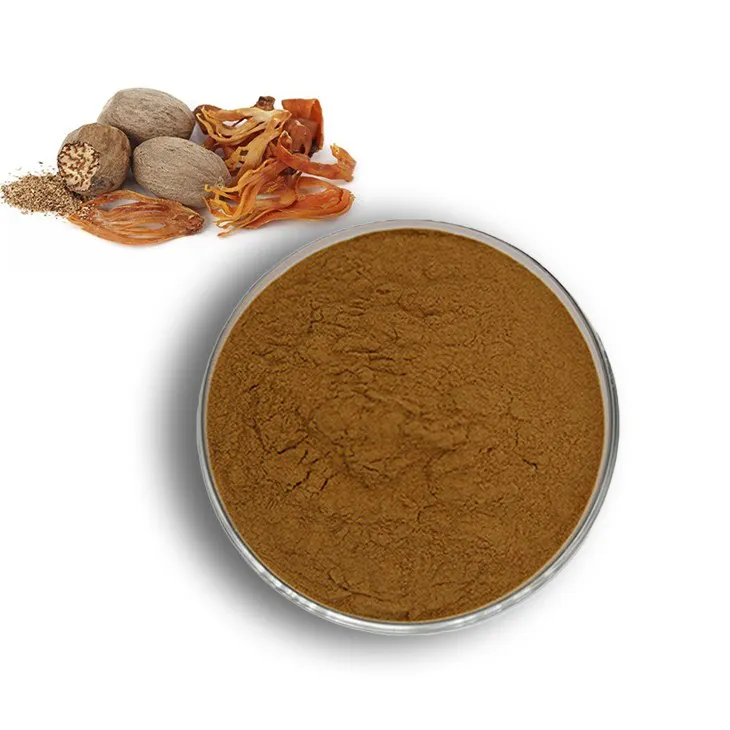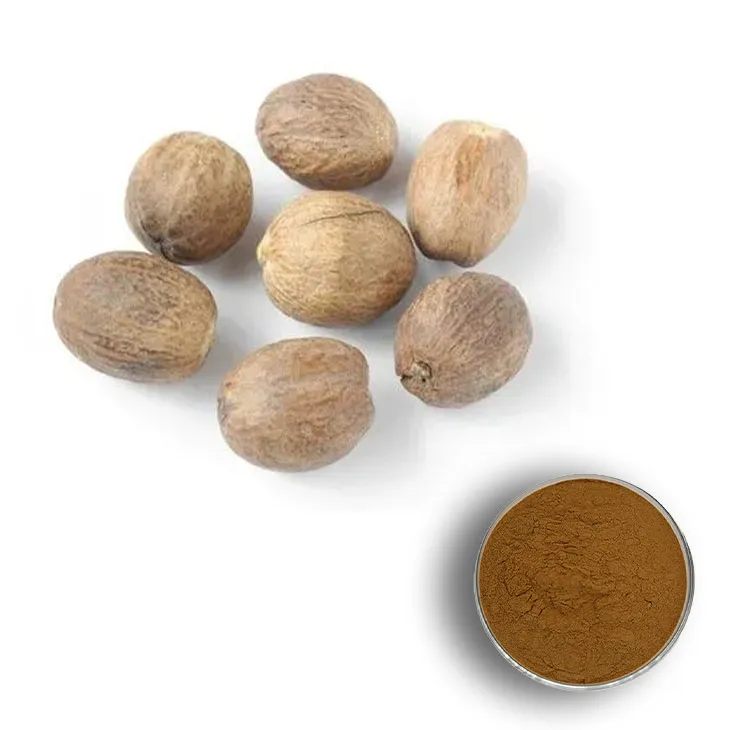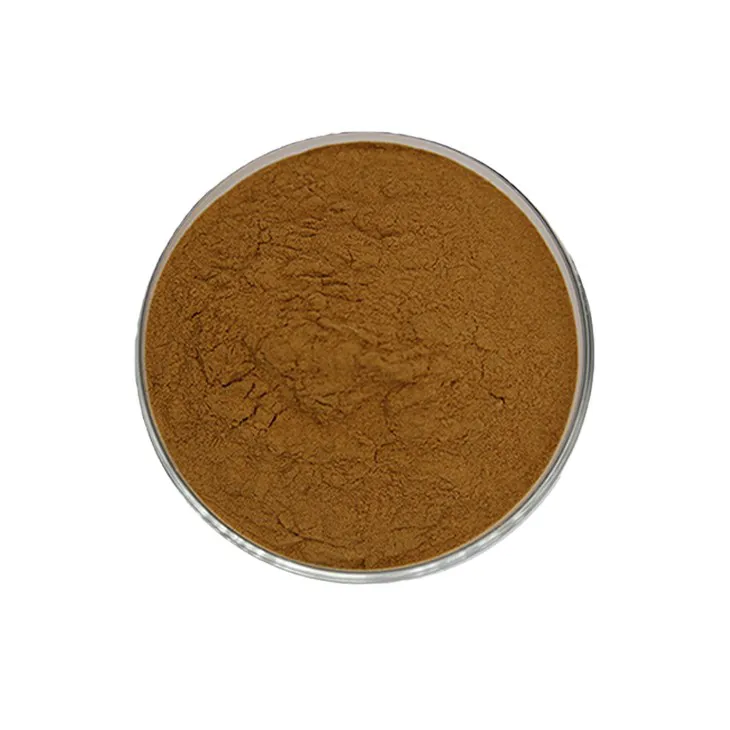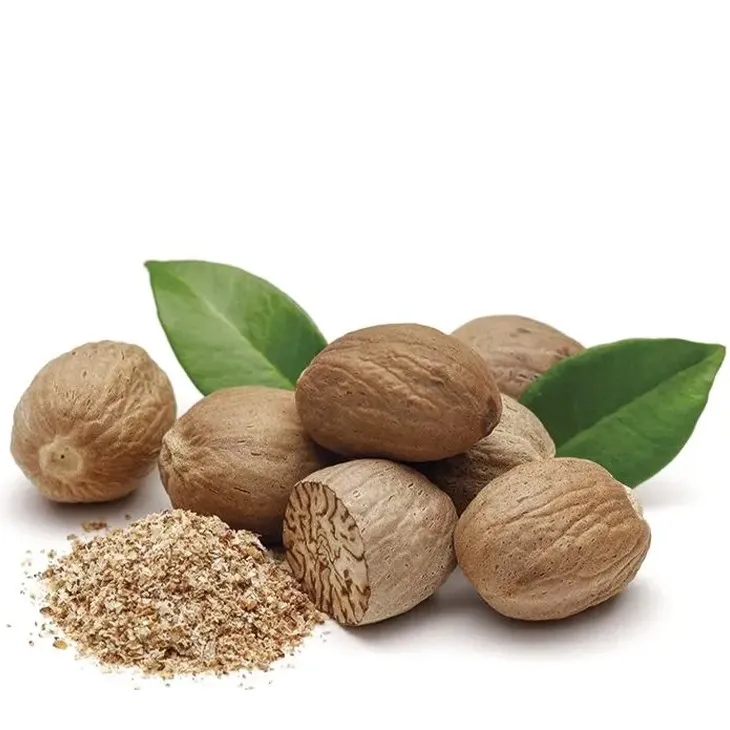- 0086-571-85302990
- sales@greenskybio.com
Nutmeg extract: Uses, advantages, and manufacturing processes.
2024-11-12

1. Introduction
Nutmeg, a spice native to the Spice Islands in Indonesia, has been used for centuries in various cultures. Nutmeg Extract, derived from this aromatic seed, is becoming increasingly popular due to its diverse range of applications. This article will explore the uses, advantages, and manufacturing processes of Nutmeg Extract.

2. Uses of Nutmeg Extract
2.1 In Food
Nutmeg extract is widely used in the food industry for its unique flavor - enhancing properties. It adds a warm, sweet, and slightly spicy flavor to a variety of dishes and beverages.
- In baking, it is a common ingredient in cakes, cookies, and pies. For example, a traditional apple pie recipe often includes a dash of nutmeg extract to complement the sweetness of the apples and the buttery crust.
- In savory dishes, it can be used in meat - based recipes such as stews and roasts. Nutmeg extract pairs well with beef, pork, and lamb, enhancing the overall flavor profile of the dish.
- It is also used in the production of flavored beverages. Hot chocolate, for instance, can be made even more indulgent with a touch of nutmeg extract, adding a depth of flavor that is both comforting and luxurious.
2.2 In Medicine
Nutmeg extract has been the subject of numerous studies for its potential health - promoting effects.
- It has been suggested that nutmeg extract may have anti - inflammatory properties. Inflammation is a key factor in many chronic diseases, and substances with anti - inflammatory effects are of great interest in the field of medicine.
- Some research indicates that it may also have antimicrobial properties. This could potentially be useful in the development of new treatments for infections caused by bacteria, fungi, or viruses.
- There is also evidence to suggest that nutmeg extract may play a role in digestive health. It may help to relieve symptoms such as indigestion, bloating, and abdominal pain.
2.3 In the Beauty Field
Nutmeg extract has found its way into the beauty industry, where it is valued for its beneficial effects on the skin.
- It is believed to help in maintaining the skin's natural beauty. Nutmeg extract may have antioxidant properties, which can protect the skin from damage caused by free radicals. Free radicals are unstable molecules that can cause premature aging, wrinkles, and other skin problems.
- Some beauty products containing nutmeg extract are used for exfoliating the skin. The extract can help to remove dead skin cells, leaving the skin feeling smooth and looking radiant.
- It may also have a role in treating certain skin conditions. For example, it could potentially be used in products designed to soothe acne - prone skin or reduce the appearance of scars.

3. Advantages of Nutmeg Extract
3.1 Rich in Bioactive Compounds
Nutmeg extract is a rich source of bioactive compounds, which are substances that have a biological effect on living organisms. These compounds are responsible for many of the beneficial properties associated with nutmeg extract.
- One of the key bioactive compounds in nutmeg extract is myristicin. Myristicin has been shown to have antioxidant, anti - inflammatory, and antimicrobial properties. It is also thought to play a role in the potential health - promoting effects of nutmeg extract in the body.
- Another important compound is eugenol. Eugenol has analgesic (pain - relieving) and anti - inflammatory properties. It is also used in dentistry for its numbing effect on the gums.
- The presence of these and other bioactive compounds in nutmeg extract makes it a valuable ingredient in various applications, from food and medicine to beauty products.
3.2 Sustainability in Production
In today's environmentally - conscious world, the sustainability of production processes is of utmost importance. Nutmeg extract production has several aspects that contribute to its sustainability.
- Nutmeg trees are relatively easy to cultivate in their native regions. They can be grown in a sustainable manner, with proper agricultural practices. This ensures a continuous supply of nutmeg for extract production without causing significant damage to the environment.
- The extraction process can be optimized to minimize waste and energy consumption. By using efficient extraction techniques, manufacturers can reduce their environmental footprint while still producing high - quality nutmeg extract.
- Furthermore, the by - products of nutmeg extraction can often be utilized in other industries. For example, the leftover parts of the nutmeg seed after extraction can be used for animal feed or in the production of biofuels, adding to the overall sustainability of the process.

4. Manufacturing Processes of Nutmeg Extract
4.1 Collection of High - Quality Nutmeg
The first step in the manufacturing process of nutmeg extract is the collection of high - quality nutmeg. This is crucial as the quality of the raw material directly affects the quality of the final extract.
- Nutmeg is typically harvested from mature nutmeg trees. The fruits of the nutmeg tree are first collected. These fruits are oval - shaped and contain a single seed, which is the nutmeg.
- After collection, the fruits are carefully processed to remove the outer shell and obtain the nutmeg seed. The nutmeg seeds are then sorted to ensure that only the highest quality seeds are used for extraction.
- Quality control at this stage involves checking for factors such as size, shape, color, and absence of damage or disease. Only seeds that meet the strict quality standards are selected for further processing.
4.2 Extraction Techniques
Once high - quality nutmeg seeds are obtained, the next step is to extract the useful components from the seeds. There are several extraction techniques that can be used, each with its own advantages and disadvantages.
- Solvent extraction is one of the most common methods. In this process, a suitable solvent such as ethanol or hexane is used to dissolve the bioactive compounds in the nutmeg seed. The nutmeg seeds are soaked in the solvent, and the compounds are then extracted into the solvent. This method is relatively efficient and can produce a high - yield of extract. However, it requires careful handling of the solvent to ensure safety and environmental compliance.
- Supercritical fluid extraction is another technique that is gaining popularity. Supercritical fluids, such as supercritical carbon dioxide, are used as the extraction medium. Supercritical fluids have properties that are intermediate between a gas and a liquid, which makes them excellent solvents for extracting bioactive compounds. This method has the advantage of being more environmentally friendly as carbon dioxide is a non - toxic and easily recyclable solvent. It also produces a purer extract with a higher concentration of bioactive compounds.
- Steam distillation can also be used to extract essential oils from nutmeg. While this method is mainly used for obtaining essential oils rather than the full range of bioactive compounds in nutmeg extract, it is still an important extraction technique in the nutmeg industry. Steam is passed through the nutmeg seeds, and the volatile compounds are carried away with the steam and then condensed to obtain the essential oil.
4.3 Filtration for Purification
After the extraction process, the resulting extract contains not only the desired bioactive compounds but also impurities such as solvent residues, plant debris, and other unwanted substances. Filtration is therefore an essential step in the manufacturing process to purify the nutmeg extract.
- There are different types of filtration methods that can be used depending on the nature of the impurities and the desired purity of the extract. Microfiltration can be used to remove larger particles such as plant debris. This involves passing the extract through a membrane with pores of a specific size that allow the bioactive compounds to pass through while retaining the larger particles.
- Ultrafiltration is used for further purification by removing smaller molecules such as solvent residues. Ultrafiltration membranes have smaller pores than microfiltration membranes, allowing for a more refined purification process.
- Filtration not only improves the purity of the nutmeg extract but also enhances its stability and shelf - life. A purer extract is less likely to degrade over time, ensuring that it retains its beneficial properties for a longer period.
4.4 Strict Quality Inspection
The final step in the manufacturing process of nutmeg extract is strict quality inspection. This ensures that the extract meets the required quality standards for its intended applications.
- Quality inspection involves testing for various parameters such as the concentration of bioactive compounds, purity, and absence of contaminants. Analytical techniques such as high - performance liquid chromatography (HPLC) are often used to accurately measure the concentration of bioactive compounds in the extract.
- Microbiological testing is also carried out to ensure that the extract is free from harmful microorganisms such as bacteria, fungi, and viruses. This is especially important for nutmeg extract that is intended for use in food, medicine, or beauty products.
- Only after passing all the quality inspection tests can the nutmeg extract be considered ready for packaging and distribution. This strict quality control process helps to ensure that consumers receive a high - quality product that is safe and effective.

5. Conclusion
Nutmeg extract is a versatile substance with a wide range of uses in food, medicine, and the beauty field. Its advantages, including being rich in bioactive compounds and having a sustainable production process, make it an attractive ingredient for various industries. The manufacturing process of nutmeg extract, from the collection of high - quality nutmeg to strict quality inspection, is complex but essential for producing a pure and effective extract. As research on nutmeg extract continues, it is likely that even more applications and benefits will be discovered in the future.
FAQ:
What are the main uses of nutmeg extract in the food industry?
Nutmeg extract is used to enrich the flavor profile of various dishes and beverages in the food industry. It can add a unique and pleasant taste to things like baked goods, soups, and certain alcoholic or non - alcoholic drinks.
What potential health - promoting effects does nutmeg extract have in medicine?
While research is still ongoing, nutmeg extract is being studied for potential health - promoting effects in medicine. Some studies suggest it may have properties related to anti - inflammation, digestion improvement, and more, but more research is needed to fully understand and confirm these effects.
How does nutmeg extract help in maintaining skin's natural beauty in the beauty field?
In the beauty field, nutmeg extract contains certain components that can help with skin health. It may contribute to maintaining the skin's natural beauty by providing antioxidant effects, which can help protect the skin from damage caused by free radicals, and potentially by improving skin texture and tone.
What are the bioactive compounds in nutmeg extract and why are they beneficial?
Nutmeg extract is rich in bioactive compounds such as essential oils, phenolic compounds, and others. These are beneficial as they can have antioxidant, anti - inflammatory, and antimicrobial properties. For example, the essential oils can contribute to the flavor and potentially have some biological activities, while phenolic compounds are often associated with health - promoting antioxidant effects.
What are the key steps in the manufacturing process of nutmeg extract?
The manufacturing process of nutmeg extract starts with the collection of high - quality nutmeg. Then, extraction techniques are used to draw out the useful components. After that, filtration is carried out for purification purposes. Finally, strict quality inspection is done to ensure the production of a pure and effective extract.
Related literature
- Nutmeg Extract: A Comprehensive Review of Its Chemical Composition and Potential Applications"
- "The Health Benefits and Manufacturing Aspects of Nutmeg Extract: An In - depth Analysis"
- "Nutmeg Extract in Food, Medicine, and Cosmetics: Properties and Processing"
- ▶ Hesperidin
- ▶ citrus bioflavonoids
- ▶ plant extract
- ▶ lycopene
- ▶ Diosmin
- ▶ Grape seed extract
- ▶ Sea buckthorn Juice Powder
- ▶ Beetroot powder
- ▶ Hops Extract
- ▶ Artichoke Extract
- ▶ Reishi mushroom extract
- ▶ Astaxanthin
- ▶ Green Tea Extract
- ▶ Curcumin Extract
- ▶ Horse Chestnut Extract
- ▶ Other Problems
- ▶ Boswellia Serrata Extract
- ▶ Resveratrol Extract
- ▶ Marigold Extract
- ▶ Grape Leaf Extract
- ▶ blog3
- ▶ blog4
- ▶ blog5
-
Organic Tongkat Ali extract powder factory.
2024-11-12
-
How to make powder with ashwagandha extract.
2024-11-12
-
Rosehip extract manufacturers from China.
2024-11-12
-
The best cat's claw extract in nature.
2024-11-12
-
Chinese Dandelion Leaf Extract Suppliers.
2024-11-12
-
Acerola Juice Powder
2024-11-12
-
Bayberry Extract
2024-11-12
-
Soy Extract
2024-11-12
-
Mulberry leaf Extract
2024-11-12
-
Camu Camu Extract
2024-11-12
-
Black Garlic Extract
2024-11-12
-
Peppermint Oil
2024-11-12
-
Grapefruit Seed Extract Powder
2024-11-12
-
Saffron Extract Powder
2024-11-12
-
Polygonum multiflorum extract
2024-11-12





















